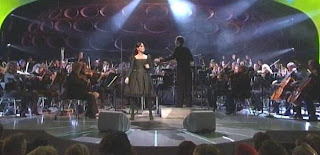
This is a Dutch singer. Hence the name, all those consonants and just two vowels in the first name. I know it may seem strange but hold on.
Judith Katrijntje Oosterhuis was born on February 5, 1973 in Amsterdam. She is currently the leading vocalist in The Netherlands.
The short story is that she started out and became a major success in Holland working with her brother in a pop band called Total Touch. As their bio notes: they sold “more than a million records over a four-year period (1996-1999) – in a small country where 80.000 is already considered platinum.” Total Touch was all the rage until Trijntje decided that was not the way she wanted to go with her career.
The short story is t all the rage until Trijntje decided that was not the way she wanted to go with her career.
So she did some solo outings in her transition from the fame/fortune of Total Touch to her next plateau. Another platinum seller was her live album of Stevie Wonder songs. And then record companies showered her with offers. She ended up on EMI/Blue Note.
She produced two albums that had a contemporary urban pop sound. Representative of that direction I’ve included one cut, “All Around The World” from her 2003 self titled album, Trijntje Oosterhuis.
She could have easily gone that way except she was more interested in two other genres: soul and jazz.
Trijntje did a jazz album that focused on the music of Billie Holiday and George Gershwin, big band arrangements with strings. The music was buffed to a radio-friendly sheen and again enjoyed great success.
The cut “Man I Love” is from her 2004 Strange Fruit album which, despite the title, had a romantic and optimistic sound. The album went double-platinum. Then another adult pop album. Back and forth, all commercially successful.
For me this music is one (medium) step removed from expensive wallpaper, by which I mean there is a certain attractiveness to it as background but I don’t find it particularly engaging for serious listening. Nevertheless, I am clearly in the minority of those who have been exposed to these recordings. I suspect my hard jazz heart just doesn’t respond to this direction, which sounds suspiciously like a kissing cousin of smooth jazz.
Next came a major development an album of Burt Bacharach songs—they even got Bacharach to play piano on a couple of cuts. That was both safe and dangerous for a female singer to undertake—safe because so many Bacharach songs had been hits, dangerous because so many of them are indelibly associated with Dionne Warwick.
The gamble paid off big time with a major selling album, 2007’s Look of Love: Burt Bacharach Songbook. “The Look of Love,” “Alfie” and “Anyone Who Had A Heart (Live)” are all from that album. The live version of “Anyone” is a bonus cut on the second edition of Look of Love. FM radio loves this stuff and, to be fair, the production is first rate: real strings, professional arrangements, there is nary a miscue or mistake.
Listen to the intro of “Alfie.” With an eye toward international sales, Trijntje Oosterhuis is now billed as “Traincha.” This is music for baby boomers and the challenge is how does one keep this stuff fresh, especially as its designed to stay on the shelf for years with a long period of appealing to folks in their late forties to early sixties who remember these songs as the music of their youth.
The live cut, “Anyone Who Had A Heart” has a bit more bite to it and as such is more to my taste. Sales were so brisk that Blue Note did what most majors do when they have a winner: they double down and try to cash in. In Trijntje’s case they produced a second album of Bacharach songs, Who’ll Speak For Love (2008).
Enjoy 1 hour of good jazz concert from the no.1 jazz singer of Netherlands and beautiful arrangements of Vince Mendoza. Vince has been notably known from some of the best jazz artists he has been with. Like Herbie Hancock, Joni Mitchell, Joe Zawinul and so on....


 of music no one had really heard before. It was much like a ballad, and although she didn’t get a lot of attention (there was a lot of talking going on), she didn’t get booed off stage either. I was impressed by the courage she demonstrated to sing an alternative selection. She sang well. She had great stage presence, and although she didn’t play anything popular, she was good enough to have people stand there and listen to her, and that’s when I realized that she had broader experiences, at least musically, than most people at that age. She sang that song because she loved it, and she didn’t care if you liked that song or not, and I respected her for that” .
of music no one had really heard before. It was much like a ballad, and although she didn’t get a lot of attention (there was a lot of talking going on), she didn’t get booed off stage either. I was impressed by the courage she demonstrated to sing an alternative selection. She sang well. She had great stage presence, and although she didn’t play anything popular, she was good enough to have people stand there and listen to her, and that’s when I realized that she had broader experiences, at least musically, than most people at that age. She sang that song because she loved it, and she didn’t care if you liked that song or not, and I respected her for that” . 








